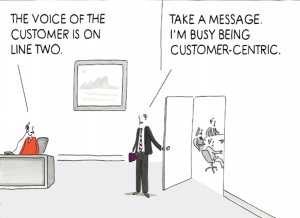We know the theory and we know we need to be more customer centric. The biggest challenge for many organisations is how do it, at both the strategic organisational level and at the more tactical operational level.
I’ve worked with and for many organisations going through their own journey to be more customer centric, at both large well-established global organisations and more niche startup organisations and have been privileged to be in positions with them where I’ve been part of that change.
One of the more strategic level changes that is crucial for success is getting your customer leadership at the right level. It’s great to see more and more organisations across different industries and sectors investing in Chief Customer Officer or similar exec level roles now and the number has grown significantly over the last few years (and continues to grow).
Having the right leadership gives you the voice of the customer at the leadership table, having someone focused on driving customer growth and value and bringing the customer conversations to the exec and board level.
I really like this concise definition of a Chief Customer Officer:
“An executive who provides the comprehensive and authoritative view of the customer and creates corporate and customer strategy at the highest levels of the company to maximise customer acquisition, retention, and profitability.”
The customer leadership role – Chief Customer Officer or other – gives you:
- Visibility – to understand and see what is happening to your customers
- Clarity – of what happens when a prospect becomes a customer
- Balance of power – creating the 3rd organisational pillar (with sales and operations)
- Sales focus – allowing sales to focus on new business without customer distractions
- Feedback – into what is happening outside of the business (the so called magic loop)
- Signalling – the external messaging that we are customer centric
The magic loop above is:
Plan and Build (product management and engineering) vs. Demand and Sales (Marketing and Sales) vs. Customer Experience (Customer Success).
At the more tactical level though – in terms of things you could do more immediately – here are a number of great practical ideas for driving customer centricity in your organisation:
- Create a mission statement that impacts your customers and that includes customers
- Be a customer – yes role play (across all teams)
- Visit your customers – all execs and, even better, all teams
- Implement a customer forum or community (customers talking to each other)
- Create a voice of customer programme (and close that feedback loop)
- Bring your customer feedback into every meeting across the business
- Democratise customer insights and make them visible to everyone in the organisation
- Link team compensation to the customer and have customer focused goals
- Hire for customer orientation and customer empathy (and onboard them like customers)
I really, really like Amazon’s mission statement:
Numbers 6 and 7 above can be very powerful when done well and I’ve seen the idea of a customer feedback wall used very well and to great effect – where you include and share the very, very good, the good, the bad and the ugly.
Do these ideas resonate with you? What things have you done in your organisations to drive the journey to being more customer centric? And what has the impact been with your customers?
If you’re interested in chatting customer centricity or customer success, please do reach out to me – I always love hearing your own journeys and challenges and ideas (and good coffee).
And don’t forget to listen to my latest podcast with Jason Whitehead from Trituns on getting your customer onboarding right from earlier this month. Click here to listen to this one and others in the series.












